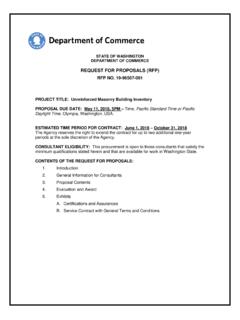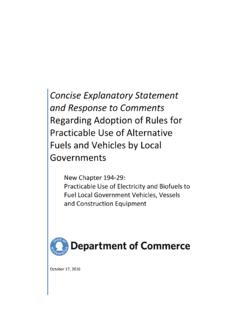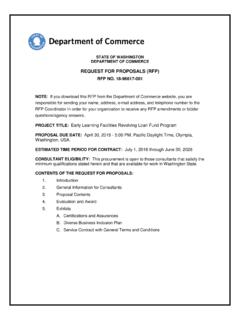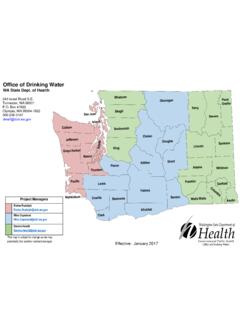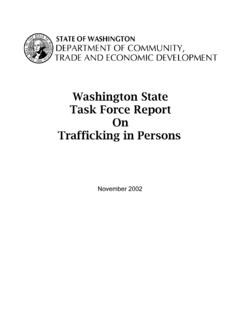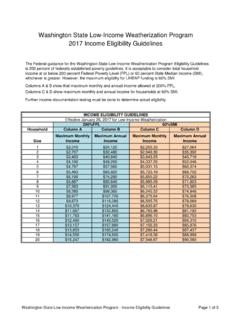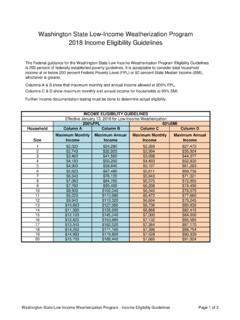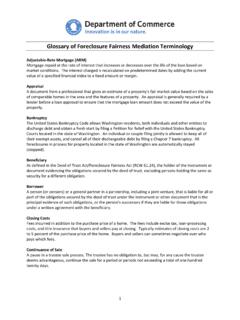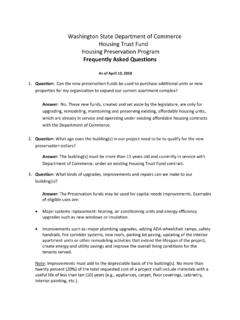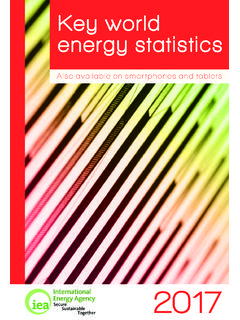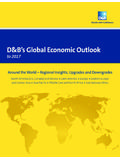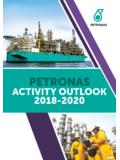Transcription of Petroleum Supply and Use in Washington State
1 Petroleum Supply and Use in Washington State An Overview of Recent Developments in the Petroleum Market October 2013 Brian Bonlender, Director Acknowledgements Washington State Department of Commerce Tony Usibelli, Director, State Energy Office Greg Nothstein, Energy Program Specialist, Project Manager Roel Hammerschlag, Senior Energy Program Specialist This document is an update of a 2006 Petroleum white paper authored by the State Energy Office. Greg Nothstein Washington State Department of Commerce State Energy Office 1011 Plum St. SE Box 42525 Olympia, WA 98504-2525 For people with disabilities, this report is available on request in other formats. To submit a request, please call 360-725-4000 (TTY 360-586-0772). Petroleum Supply and Use in Washington State Table of Contents Executive Summary.
2 1 Introduction .. 3 Historical and Forecast Primary Energy and Petroleum Consumption .. 4 Petroleum Resources, Domestic Production and 14 Transport and Refining of Crude Oil and Distribution of Refined Products .. 25 Crude Oil and Refined Petroleum Product Prices and Expenditures .. 32 Causes of Price Volatility in the Petroleum Market .. 39 Greenhouse Gas Emissions Associated with Petroleum 46 Alternative Fuels and Technology to Replace Petroleum Products .. 50 Recent Policy Directions .. 53 Appendix A: Common energy units .. 55 Appendix B: Brief overview of Peak Oil .. 56 Appendix C: Liquid Fuel Prodcution Forecast.. 59 Appendix D: Challenges Forecasting Petroleum Resources, Supply , Demand and Prices .. 60 Appendix E: Crude Oil Price Differentials.. 64 Appendix F: Electric vehicle competitiveness battery cost vs. gasoline price.
3 65 Petroleum Supply and Use in Washington State Executive Summary Global Petroleum Demand and Production Global demand for Petroleum products has grown at percent per year over the last decade. Over the next two decades demand for coal, natural gas, nuclear, and renewable energy is expected to grow rapidly, and Petroleum s share of the global energy pie is expected to decline from 33 percent today to about 28 percent by 2030. Global Petroleum demand growth is being driven by developing nations such as China, India, Brazil, and Indonesia. Developed nations such as the , Germany, and Japan have stable or decreasing demand, caused primarily by a combination of slow growing populations, static demand for more vehicles, and increasing fuel economy standards. Currently, developed and developing nations consume approximately 45 million barrels per day, but in coming decades developing nations will dominate Petroleum consumption.
4 Canada, Brazil, the , Saudi Arabia, and a few other nations are increasing production of Petroleum and other liquid fuels (synthetic liquids and biofuels) to meet demand. Norway, the United Kingdom, and Mexico have declining production, while China, Venezuela, Mexico, Iraq, and Iran have the potential to increase production but face technological or political hurdles to do so. The Organization of Petroleum Exporting Countries (OPEC) is a Petroleum cartel which controls about 40 percent of global production. It has some control over Petroleum prices. OPEC also controls most of the world s Petroleum reserves. These reserves have lower production costs than the oil sands, heavy oil, offshore, and tight oil being developed in non-OPEC nations. Static demand in the developed world and increasing production from unconventional resources outside of OPEC will shift trade balances, with North America becoming more energy self-sufficient and less concerned about political developments in OPEC countries.
5 In contrast, China and India are increasing their Petroleum imports and will become more concerned or involved in political developments in Petroleum exporting countries. Petroleum Demand and Production demand for Petroleum and its refined products reached a peak in 2005, but declined 13 percent by 2012. Several factors contributed to the decline, including the 2007-09 recession, persistent high fuel prices, and increasing vehicle fuel economy standards. demand is forecast to decline for a few more years but begin slowly increasing in the next decade. production of Petroleum and other liquid fuels has rebounded strongly after reaching a low in 2005. The increase is being driven by expansion of tight oil, natural gas liquids, and biofuels production. Total liquids production has increased from million barrels per day in 2005 to million barrels per day in 2012.
6 The share of imported Petroleum has declined from 61 percent in 2005 to 41 percent in 2012. Production is forecast to continue increasing until about 2020, after which production will slowly decline. Canadian Petroleum production is also growing rapidly and Canada is by far the largest source of imported oil, supplying million barrels per day in 2012. Canadian production growth has come primarily from oil sands development, more costly Petroleum Supply and Use in Washington State 1 and energy intensive than conventional reserves. In 2012 Canadian oil sands production stood at million barrels per day and is forecast to reach million barrels per day by 2030. Much of the imported Canadian oil is just passing through the , being refined into gasoline and diesel at Gulf coast refineries and then exported to central and South America markets.
7 There is limited pipeline capacity for transporting oil from the newly developed midcontinent oil sands and tight oil fields, so the midcontinent is experiencing a glut of Supply and lower oil prices. In response, the capacity to transport oil by rail tanker is growing rapidly. Rail tanker deliveries of midcontinent crude oil to Washington State refineries have recently started. The is still a net importer of Petroleum , but in 2011 the transitioned from net importer to net exporter of refined Petroleum products. The expansion of Petroleum extraction and refining industries, besides reducing imports and boosting exports of refined products, has contributed significantly to job growth over the last several years. A PricewaterhouseCoopers study reported the Petroleum and natural gas industry added 600,000 jobs during 2010 and 2011. Petroleum and refined product prices While the prospects for higher Petroleum production in North America appear good over the next dozen years, most of the conventional reserves lie in OPEC nations.
8 The oil sand reserves in Canada are large, but long development times and high extraction costs mean that only sustained high world crude oil prices can spur production. Even with increasing North American production, Petroleum is an internationally traded commodity and the North American price will continue to be set by international markets. Consequently, Petroleum prices will likely remain above 100 dollars per barrel so Washington consumers should not expect to see significant reductions in gasoline and diesel prices. Unpredictable events, like a global financial crisis or political turmoil in a major OPEC exporting nation, could cause Petroleum prices to swing above or below the standard price forecast. In addition, refinery or pipeline accidents can contribute to regional fuel price spikes of relatively short duration. Increasing light duty vehicle fuel efficiency will act to reduce the impact of higher Petroleum and prices and price spikes on consumers.
9 Beyond Petroleum Petroleum has been the largest source of fossil fuel energy in the since 1950, and the primary transportation fuel for nearly a century. Increasing concerns over greenhouse gas emissions, State and national trade balances, and energy security have combined with price pressure to push the nation and states toward alternatives to Petroleum . Electric generation and home heating, for example, have become far less dependent on Petroleum over the past forty years as price has increased. In the transportation sector it has been much more difficult to find replacements for Petroleum . But now biofuels, such as cellulosic ethanol and biodiesel, are slowly entering the transportation fuel market. New types of vehicles such as hybrids, plug-in hybrids, pure electric vehicles, and advanced diesels use less or no Petroleum ; and as of 2013 their collective market share was 5 percent, and is likely to increase.
10 Petroleum Supply and Use in Washington State 2 Introduction Petroleum is the most common primary energy1 source globally, in the United states , and Washington State . It supplied 33 percent of world, 36 percent of ,2 and 46 percent of Washington s primary energy needs in 2011. Refined products derived from Petroleum are primarily, but not exclusively, used for transportation purposes and are essential for our modern, mobile way of life. The word Petroleum means rock oil or oil from the earth. In its unrefined State Petroleum is usually called crude oil. After refining it generally takes the name of a refined Petroleum product such as gasoline, diesel, fuel oil, and so forth, which are collectively referred to as refined products. Recently, growing natural gas liquids, synthetic liquids and biofuels production have added to the Petroleum stream, and analysts are referring to the combination as Petroleum and other liquids, or sometimes total liquid fuels.
